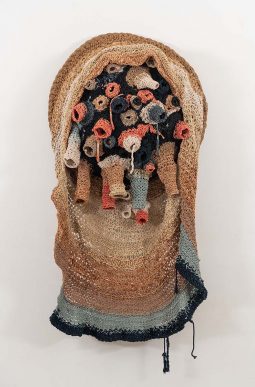C&L Shows
Depth Charge
Moumita Das
2023

Overview
Exhibition Text by Kedar A Kulkarni
Depth Charge is a homage to many histories: to a history of abstraction, scientific drawings, technical sketches, to the practices and techniques of weavers and dyers, and perhaps also, to domestic labor, which is often omitted from the category of art altogether. Despite these many resonances, Das’ work remains intensely personal too. Histories and personal life mingle as memories and experiences assume an artistic form. Throughout Depth Charge, Das’s work exhibits a tension and collusion between these poles. To engage with her art, therefore, is to visit multiple sites of inspiration and critique.
Take the many “wounds” in this exhibit—almost concentric circles—with centers and rings around them. They are abstract, and we search our psyches for a semblance of meaning. We may ask ourselves the old-fashioned question: “is this beautiful”? or some less idealistic version of it: would I like this on my wall? Immediately, we notice that Das uses a variety of techniques here: crocheting, threadwork, vegetable dying, applique, etc. The color palette too, is an affirmation of some of these techniques. For example, the works with vegetable dyes are unmistakable, and their blues, reds, greys, and browns undeniably familiar to the Indian eye. Even the fully-knit and woven works employ hemp, cotton, jute, and wool: four organic materials that are both easy on the eyes and body, and in abundant supply. The play of color, shape, line, and shading evokes a multiplicity of objects in our world. Some are ocular. Others, like the rings of a tree. Perhaps a flame.
We want to project onto them what we wish to see, but Das tells me her work describes forms of civic strife, beyond specifically gendered versions. An outside cannibalizing an inside, an inside too suffocated to break free. They have something to say something about violence and oppression. She tells me that people have asked if her work is feminist—as indeed some of the shapes may seem, interpretively, feminine. She has a practiced reply: oppression doesn’t necessarily know a gender, the powerful always oppress those below them. My wife, who has overheard our garrulous conversation, later wishes she could say, “aww, you are a feminist, just not a shitty girl boss kind who believes in the redemptive power of capitalism.” Note to all reading this: capitalism will not provide redemption.
Normally, I hesitate to speak biographically. For artists, and especially for women artists, critics who speak biographically often pathologize the art. But a few of Das’s recollections are too revealing to pass up. Before college, Das expressed almost no interest in threadwork and crocheting. Instead, she declined her mother’s offers to teach her—it was all too “homely” she tells me, too domestic and mundane. But at Viswabharati, Das became interested in tapestry, and realized how similar it is to threadwork and crocheting. When she asked her mother if the offer to teach crocheting still stands, it was her mother’s turn to (almost) decline. Her mother asked what had changed Moumita’s mind, and why she wanted to learn now. It is a flexible medium, can be two or three dimensional, and accommodates a range of techniques…and designers also use it, she told her mother. They both had a laugh; we both share a laugh, and I say something about the prodigal son, and art history’s prodigal sons.
With her father, the recollection is even more schmaltzy, and this recent father is hooked. Das’s father is a civil engineer, stationed for some time in Kakdwip, a small port on the Hooghly River delta. He had special oversight of jetties and bridges in the area, for which he drafted technical drawings. Back then, Das was in the eighth standard, and learning about sketching and scientific drawings at school. As if divining a future, her father suggested she enhance his technical drawings of jetties with fish, prawns, and other natural leitmotifs. Just like that—her first “professional” work came to be. I wonder if this could be a future direction for her work, substantially less anodyne than the trees and bushes within an architect’s rendering. Works such as Formation of Nature showcase this relationship with nature. The oddity and success of the piece, for me, is its alien appearance, gesturing towards some natural form, but rendered as a human object. Even though the pigments and dyes and thread are organic, a work of art is nothing short of human artifice. Formation of Nature disorients me precisely because as art, it appears “natural” in a gallery, deftly commenting on the distance between the artistic (human) world and the natural world.
Works in Depth Charge repeatedly echo the natural world, as produced and reshaped through human activity. Volcanic Source is particularly insightful in this regard. In this and a few others, the medium—woven thread—takes on a special significance. Modern computing owes something to textile mills from the nineteenth century, which operated through punched cards on a Jacquard machine. Weaving, in a sense, was the first kind of pixelated image, uniformly reducing patterns and the world to a series of squares that could be produced through warps and wefts. These works explode that consistency, and disturb the expectations we harbor of textiles and pixelation. They are, in a word, gross, precisely because of their unexpected deformity. They have a visceral quality as if innards have been exposed. Formally speaking, therefore, Das deliberately draws attention to her medium as she accommodates nature into it. Politically, nature and human activity have always exceeded our efforts to fit them into neat (pixelated) boxes.
As a blotted and bloated sun sets over Santiniketan (Summer Sunset at Shantiniketan), I am reminded of innumerable sunsets and sunrises, from painting, from cinema, and from personal experience. And yet, none of them are quite like Summer Sunset.
Moumita Das | Depth Charge | Digital Catalogue
A Video Walkthrough by Mort Chatterjee

















